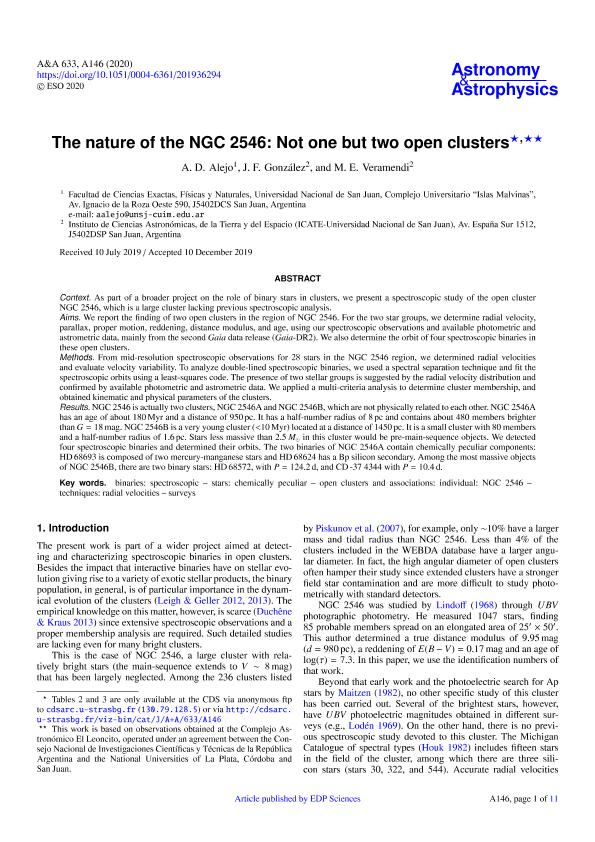Mostrar el registro sencillo del ítem
dc.contributor.author
Alejo, Antonio Damian

dc.contributor.author
Gonzalez, Jorge Federico

dc.contributor.author
Veramendi Pont, María Eugenia

dc.date.available
2021-10-07T17:11:58Z
dc.date.issued
2020-01
dc.identifier.citation
Alejo, Antonio Damian; Gonzalez, Jorge Federico; Veramendi Pont, María Eugenia; The nature of the NGC 2546: Not one but two open clusters; EDP Sciences; Astronomy and Astrophysics; 633; 146; 1-2020; 1-11
dc.identifier.issn
0004-6361
dc.identifier.uri
http://hdl.handle.net/11336/143175
dc.description.abstract
Context. As part of a broader project on the role of binary stars in clusters, we present a spectroscopic study of the open cluster NGC 2546, which is a large cluster lacking previous spectroscopic analysis. Aims: We report the finding of two open clusters in the region of NGC 2546. For the two star groups, we determine radial velocity, parallax, proper motion, reddening, distance modulus, and age, using our spectroscopic observations and available photometric and astrometric data, mainly from the second Gaia data release (Gaia-DR2). We also determine the orbit of four spectroscopic binaries in these open clusters. Methods: From mid-resolution spectroscopic observations for 28 stars in the NGC 2546 region, we determined radial velocities and evaluate velocity variability. To analyze double-lined spectroscopic binaries, we used a spectral separation technique and fit the spectroscopic orbits using a least-squares code. The presence of two stellar groups is suggested by the radial velocity distribution and confirmed by available photometric and astrometric data. We applied a multi-criteria analysis to determine cluster membership, and obtained kinematic and physical parameters of the clusters. Results: NGC 2546 is actually two clusters, NGC 2546A and NGC 2546B, which are not physically related to each other. NGC 2546A has an age of about 180 Myr and a distance of 950 pc. It has a half-number radius of 8 pc and contains about 480 members brighter than G = 18 mag. NGC 2546B is a very young cluster (<10 Myr) located at a distance of 1450 pc. It is a small cluster with 80 members and a half-number radius of 1.6 pc. Stars less massive than 2.5 M☉ in this cluster would be pre-main-sequence objects. We detected four spectroscopic binaries and determined their orbits. The two binaries of NGC 2546A contain chemically peculiar components: HD 68693 is composed of two mercury-manganese stars and HD 68624 has a Bp silicon secondary. Among the most massive objects of NGC 2546B, there are two binary stars: HD 68572, with P = 124.2 d, and CD -37 4344 with P = 10.4 d.
dc.format
application/pdf
dc.language.iso
eng
dc.publisher
EDP Sciences

dc.rights
info:eu-repo/semantics/openAccess
dc.rights.uri
https://creativecommons.org/licenses/by-nc-sa/2.5/ar/
dc.subject
BINARIES: SPECTROSCOPIC
dc.subject
STARS: CHEMICALLY PECULIAR
dc.subject
OPEN CLUSTERS AND ASSOCIATIONS
dc.subject
TECHNIQUES: RADIAL VELOCITIES
dc.subject.classification
Astronomía

dc.subject.classification
Ciencias Físicas

dc.subject.classification
CIENCIAS NATURALES Y EXACTAS

dc.title
The nature of the NGC 2546: Not one but two open clusters
dc.type
info:eu-repo/semantics/article
dc.type
info:ar-repo/semantics/artículo
dc.type
info:eu-repo/semantics/publishedVersion
dc.date.updated
2021-08-19T20:35:15Z
dc.journal.volume
633
dc.journal.number
146
dc.journal.pagination
1-11
dc.journal.pais
Francia

dc.description.fil
Fil: Alejo, Antonio Damian. Universidad Nacional de San Juan. Facultad de Ciencias Exactas, Físicas y Naturales; Argentina
dc.description.fil
Fil: Gonzalez, Jorge Federico. Consejo Nacional de Investigaciones Científicas y Técnicas. Centro Científico Tecnológico Conicet - San Juan. Instituto de Ciencias Astronómicas, de la Tierra y del Espacio. Universidad Nacional de San Juan. Instituto de Ciencias Astronómicas, de la Tierra y del Espacio; Argentina
dc.description.fil
Fil: Veramendi Pont, María Eugenia. Consejo Nacional de Investigaciones Científicas y Técnicas. Centro Científico Tecnológico Conicet - San Juan. Instituto de Ciencias Astronómicas, de la Tierra y del Espacio. Universidad Nacional de San Juan. Instituto de Ciencias Astronómicas, de la Tierra y del Espacio; Argentina
dc.journal.title
Astronomy and Astrophysics

dc.relation.alternativeid
info:eu-repo/semantics/altIdentifier/url/https://www.aanda.org/10.1051/0004-6361/201936294
dc.relation.alternativeid
info:eu-repo/semantics/altIdentifier/doi/http://dx.doi.org/10.1051/0004-6361/201936294
Archivos asociados
